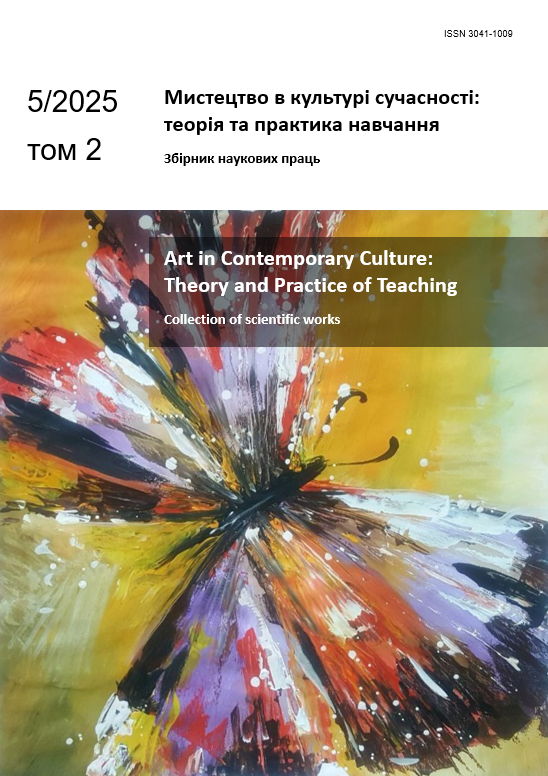Articles
HISTORICAL AND CULTURAL PREREQUISITES FOR THE FORMATION OF AMATEUR AND PROFESSIONAL FOLK DANCE ENSEMBLES IN UKRAINE (FIRST HALF OF THE 20TH CENTURY)
Published 2025-12-15
Keywords
- Ukrainian folk dance,
- professional dance ensemble,
- amateur dance ensemble,
- folk stage dance,
- concert program
Copyright (c) 2025 Юлія Москвічова

This work is licensed under a Creative Commons Attribution 4.0 International License.
How to Cite
HISTORICAL AND CULTURAL PREREQUISITES FOR THE FORMATION OF AMATEUR AND PROFESSIONAL FOLK DANCE ENSEMBLES IN UKRAINE (FIRST HALF OF THE 20TH CENTURY). (2025). Art in Contemporary Culture: Theory and Practice of Teaching, 6, 23-31. https://doi.org/10.31652/3041-1017-2025(5-2)-20
Abstract
In the 20th century, with the Bolsheviks coming to power and the formation of the USSR, organized forms of amateur artistic activity, such as folk dance ensembles, were introduced. The article attempts to trace the historical and socio-cultural factors that preceded the creation of folk dance ensembles, both amateur and professional. The purpose of the article is to clarify the historical and cultural prerequisites for the formation of professional and amateur folk dance ensembles in Ukraine in the 1930s-1950s of the 20th century. The creative activity specifics of folk dance choreographic groups are clarified. It is emphasized that the Ukraine's cultural transformation in the early 20s of the 20th century had an ideological significance, involved educating the population in the spirit of communist ideas, and was aimed at creating a new proletarian worldview. A unified "method of socialist realism" was proclaimed for all art forms, within the framework of which art, including choreography, was to be “national in its form and socialist in its content." It is noted that certain foreign political events (the First International Folk Dance Festival in London) gave rise to professional folk dance ensembles (the first of them was P. Virsky's ensemble, created in 1937). The main driving force behind the development of choreographic art during that period was the state government. It determined the direction of the folk choreography development, dictated the forms and content of choreographic performances and concert programs. The concert activities of professional dance ensembles and folk choirs had a positive impact on the creative and performing work of numerous amateur groups in Soviet Ukraine, whose activities were directed by the Central House of Folk Art of the Ukrainian SSR. The choreographic department of the Central House of Folk Art actively assisted the directors of the groups with repertoire, methodological literature, organized seminars, screenings, and other forms of training.Downloads
Download data is not yet available.
References
- Blahova T. (2017). Doslidzhennia etapiv profesionalizatsii narodno-stsenichnoi khoreohrafii v istoryko-kulturnii dynamitsi [A study of the stages of professionalization of folk-stage choreography in historical and cultural dynamics]. Journal “ScienceRise: Pedagogical Education”. № 7(15). 36-40. [in Ukrainian].
- Bohorod A.S. (1997). Ukrainskyi narodnyi tanets v pysemnykh dzherelakh [Ukrainian folk dance in written sources]. Dyvoslovo. Nº7. P. 15. [in Ukrainian].
- Borymska H. (1974). Samotsvity ukrainskoho tantsiu [Gems of Ukrainian dance]. Mystetstvo. [in Ukrainian].
- Vasylenko K. (1997). Ukrainskyi tanets [Ukrainian dance]. Kyiv : IPKHIK, 282 p. [in Ukrainian].
- Verkhovynets V.M. (1990). Teoriia ukrainskoho narodnoho tantsiu [Theory of Ukrainian folk dance]. Kyiv: Mus. Ukraine. 152 p. [in Ukrainian].
- Virskyi P.P. (1960). Dumky i porady [Thoughts and tips]. Mystetstvo, 3, 15.
- Humeniuk A.I. (1963). Narodne khoreohrafichne mystetstvo Ukrainy [Folk choreographic art of Ukraine]. Kyiv: Akademiia nauk Ukrainy. 236 p. [in Ukrainian].
- Dramaretskyi B., Tolubets N. (2021). «Kulturna revoliutsiia» pochatku 1920-kh rr., yak tekhnolohiia formuvannia radianskoho mentalitetu [The “Cultural Revolution" of the early 1920s as a technology for shaping the Soviet mentality]. EMINAK. №2. Pp. 190-199. http://nbuv.gov.ua/UJRN/eminak_2021_2_17 [in Ukrainian].
- Klymchuk I.S. (2020). Stanovlennia profesiinykh ansambliv narodnoho tantsiu v SRSR: khudozhni ta sotsiokulturni chynnyky [The Formation of Professional Folk Dance Ensembles in the USSR: Artistic and Socio-Cultural Factors]. Visnyk KNUKiM. Seriia: Mystetstvoznavstvo. Vyp. 43. P. 168–174. [in Ukrainian].
- Kosakovska L.P. (2009). Mystetska paradyhma Vasylia Avramenka v konteksti rozvytku ukrainskoi kultury XX st. [Vasyl Avramenko's artistic paradigm in the context of the development of Ukrainian culture in the twentieth century]. Avtoreferat dysertatsii kandydata mystetstvoznavstva. Derzhavna akademiia kerivnykh kadriv kultury i mystetstv, Kyiv. [in Ukrainian].
- Moskvichova Yu.O., Sushytskyi M.I. (2023). Rozvytok narodno-stsenichnoi khoreohrafii u tvorchii diialnosti V. Verkhovyntsia [Development of folk-stage choreography in the creative activity of V. Verkhovynets]. Naukovyi chasopys NPU imeni M.P. Drahomanova. Seriia 14. Teoriia i metodyka mystetskoi osvity. Vyp. 29. Kyiv. Pp. 199-206. https://doi.org/10.31392/NPU-nc.series14.2023.29.25
- Roi Ye.Ye. (2019). Istoryko-kulturni peredumovy stvorennia derzhavnoho ansambliu tantsiu Ukrainy yak formy reprezentatsii natsionalnoho mystetstva narodnoi khoreohrafii [The historical and cultural background of the creation of the State Dance Ensemble of Ukraine as a form of representation of the national art of folk choreography]. Visnyk Natsionalnoi akademii kerivnykh kadriv kultury i mystetstv. № 2. Pp. 323-327.)




